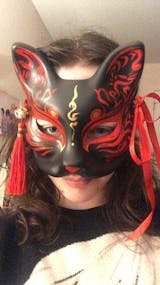Fox masks have become one of the most recognizable elements of Japanese culture both in Japan and worldwide. Symbolizing the fox spirit, the kitsune mask has special meaning within Japanese folklore, theater, and more.
Whether you're studying Japanese culture, cosplaying for fun, or looking to expand your collection, kitsune masks come in various colors and styles to suit any taste. At Eiyo Kimono, our catalog features traditional Japanese fox masks as well as fox masks from animes like Demon Slayer.
Want to know more about fox masks? In this blog, we talk about the history behind kitsune masks, the different kitsune in Japanese folklore, and more. Keep browsing our blog before shopping to learn about Japanese fashion, traditional Japanese masks, and more.
What Is a Kitsune Mask?

An integral part of Japanese culture, kitsune masks - otherwise known as fox masks - can be seen in countless forms of pop culture, mythology, art, theater, and religion. In fact, kitsune stories have existed in Japan since at least as far back as when Buddhism entered the country and mixed with the Shinto religion in the 6th century, long before the time of samurai, geisha, or even the shogunate.
But what are kitsune? Kitsune means "fox" or "foxes" in English. Throughout Japanese history, kitsune have consistently been a highly-respected animal. These foxes have taken on paranormal abilities and played a variety of roles in folk stories.
Kitsune masks are masks painted to represent these fox or kitsune characters. The most famous of these is a simple white mask with pointed ears and features painted with bold red and black paints.
These masks often receive heavy use in cosplay, Japanese festival activities, and kabuki (traditional Japanese theater), as well as in animation and film.
Kitsune Mythology
While different cultures attribute different characteristics to the fox, cleverness is one of the most universal characteristics. However, the kitsune fox goes beyond the abilities of the animals and foxes in other cultures.
In Japanese stories, kitsune have supernatural powers. Kitsune belong to a class of special creatures known as yokai, which roughly translates to "strange spirit." All kitsune yokai can change shapes, shifting into human form when it suits their goals. As such, kitsune have taken on the role of protector, friend, guardian, lover, or trickster to humans.
In the Edo period, the superstitious widely regarded kitsune as witches, goblins, or evil beings, along with other oni. In different contexts, kitsune have been considered to be familiars of the gods of the Shinto religion, namely Inari, the Japanese kami (god) of foxes, fertility, sake, tea, and the rice harvest season.
Kitsune live very long lives, sometimes up to a thousand years or more. Kitsune can also have more than one tail - up to nine, in fact. The number of tails a kitsune has directly correlates to that kitsune's age, wisdom, and power. In ritual practices, the perceived influence of a nine-tailed kitsune and its connection to the god of the rice harvest has spurred many to make prayers, offerings, or even sacrifices to these spiritual creatures.
Thirteen Types of Kitsune
In folklore, kitsune may change as they age, taking on different titles and ascending a sort of ranking system. These different types of kitsune each have different supernatural abilities, tail counts, and roles in various occasions, Japenese festivals, and rituals.
Tengoku
Tengoku roughly translates to "heaven." Tengoku kitsune have lived to be 1,000 years old. Once kitsune reach this age, they experience spiritual enlightenment, their tails turn white, and they ascend to the heavens. The original tengoku kitsune is said to have been the first fox to achieve enlightenment.
Kukan
Think of kukan as meaning "void" or "dark." The kukan kitsune masters space, illusions, and shapeshifting. This kitsune can be mischievous, but it is generally known to help humans when encountered.
Kaze
Kaze translates to "wind." Incredibly rare and rumored to be a sign of good luck, kaze kitsune vary in color and markings. However, these kitsune are very fast and command the power of the wind in Japanese folk stories.
Seishin
Also known for shapeshifting, the seishin kitsune often assumes human form to make deals with and otherwise guide humans. Some folk legends suggest seishin kitsune are special spirits capable of granting wishes and may bring good luck when sited.
Chikyu
Chikyu kitsune have a reputation for trickery and their use of fox fire. In myths, they often appear as simple foxes, an illusion that hides their power and status. Chikyu kitsune have dominion over disasters, significant events, and earthquakes.
Kawa
Like rivers, kawa kitsune are always on the move. These kitsune have voracious appetites and little regard for manners but make loyal companions for extended stays and journeys.
Umi
Umi kitsune are creatures endowed with the powers of the sea. These kitsune are often patrons of the arts, creativity, and emotion. In stories, umi kitsune appear as advice-givers, healers, and magical guides.
Yama
In Japanese, "yama" means "mountain." In folk stories, yama kitsune constantly appear and prey on the weakness and oversight of humans as a way of teaching valuable lessons about self-reliance and caution. Yama kitsune are said to be frightening, which may be one reason why kitsune are often associated with demons in pop culture and other representations.
Mori
Mori translates to "forest," and these kitsune are aptly named. Mori kitsune dwell deep in untouched wooded areas. Often when these kitsune appear in stories, they do not have as many tails as other, perhaps more powerful kitsune. Still, the potential is there.
Some mori kitsune provide help to humans while others may trick or deceive them. While they often offer benefit and moral guidance to humans, they can be powerful spirits of vengeance and should be regarded carefully.
Sanda
Said to be connected to the power of thunder, a sanda kitsune serves as messenger and protector of the gods. For humans, sanda kitsune are sometimes a sign of extreme good luck. Many stories indicate that if a person encounters a sanda kitsune, they should make a wish.
Despite the reputation for good luck, however, sanda kitsune have a dark side. If these kitsune appear in your dreams, it may be an omen of misfortune.
Jikan
Jikan kitsune has an affinity with the ebb and flow of time. Jikan kitsune have clocks for heads and are said to be able to read minds, view into the past, and alter futures.
In some areas of japan, black cats known as kitsuneko possess power over time. This power is said to be an extension of the powers of jikan kitsune.
Ongaku
Finally, "ongaku" means "music" or "sound." In Japanese stories, ongaku kitsune have golden tails and possess the power to create and play music, often being referred to as "drum kitsune."
Regardless of which type of Japanese fox a person may encounter in a folk story while wandering through Japan, a kitsune is a powerful creature. All types of kitsune can be friend or foe, guide or trickster. In most traditional Japanese mythology and within the Shinto religion, stories about the fox spirit serve as ways to educate and warn Japanese people about the dangers of trusting strangers, being unguarded in the mountains, and not attending to spiritual and philosophical responsibilities.
What Does a Kitsune Mask Symbolize?
Sometimes known as a Japanese cat mask, a kitsune masks represent the fox spirit in Shinto ritual practices, Japanese festivals, plays, movies, anime, and more. In most cases, kitsune fox masks appear as a tribute to the gods of the Shinto religion.
Kitsune Mask Wearing
Anime Cat Mask

$29.90
Mystery Meets Manga: Unleash Your Alter Ego with the Anime Cat Mask Unveil the mystique of the Orient with this exquisite Anime Cat Mask, a perfect blend of traditional craftsmanship and pop culture flair. Inspired by the vibrant world of… read more
While kitsune have roots deep mythological roots, wearing a kitsune mask is a great way to pay respect and tribute both to Japanese culture and historical celebrations.
Who Can Wear Kitsune Masks?
Fortunately, anyone can wear a kitsune mask! Because the kitsune fox mask plays an integral role in Japanese history, religion, and pop culture, it's best to use kitsune masks in respectful, culturally-appropriate ways.
Use a kitsune mask to pay tribute to your favorite animated characters or legendary figures. Additionally, feel free to wear a kitsune mask during appropriate street festivals or at events featuring mythology, rice harvest season celebrations, and other special occasions.
When To Wear a Kitsune Mask
Traditionally, natives wear the kitsune mask or fox mask during festivals to pay tribute to the gods, especially during rice harvest season. This is because kitsune, in Japanese folk stories, serve as messengers and familiars to the Inari, the Shinto god of rice and prosperity.
However, many other people wear kitsune masks for fun or creativity, including cosplayers, actors, and even characters in your favorite manga or anime.
How to Wear Kitsune Masks
Always wear a kitsune mask in culturally appropriate contexts, and do not act disrespectfully or superficially in connection with the meaning behind the masks. That said, have fun in your Japanese fox mask!
Wear these masks as part of a cosplay outfit, with a kimono or yukata, or by themselves. Simply secure the mask using the traditional string, or hold it in place with a mask stick.
How to Make Kitsune Masks
Making kitsune masks is easy! Simply paint a white fox mask with bold paint in traditional patterns.
However, thanks to the popularity and pervasiveness of kitsune masks, patrons have easy access to affordable, beautiful hand-made fox masks from skilled creators.
If you need kitsune masks, consider shopping at your favorite Japanese boutique. Eiyo Kimono offers a wide variety of fox and oni masks styled to match famous anime characters, traditional styles, and more.
The Kitsune Mask in Pop Culture
The kitsune mask is the most widely-recognized Japanese mask, followed closely by traditional oni masks. As we mentioned, kitsune masks appear in various places throughout Japanese culture. In the western world, the Japanese kitsune mask gained wide recognition through the spread of manga and anime, which are types of graphic novels and animation, respectively.
The Kitsune Mask in Anime
In Demon Slayer, one of the most widely known anime with kitsune mask elements, Sakonji made masks featuring only the fox's face. These fox masks were said to protect the slayers, warding off evil and protecting them from harmful magic.
In Kakurenbo, a short anime about a deadly and demonic game of hide and seek, the fox mask represents the trickery of the main character as she lures unsuspecting children to their doom.
The Kitsune Mask Tattoo
Tattoos have a taboo history in Japanese culture. Though the kitsune mask tattoo design typically implies trickery, guidance, or good fortune, even mythological tattoos have traditionally been viewed within Japanese society as a mark of the dreaded Yakuza.
Within other cultures, the kitsune mask tattoo meaning may change, often signifying cleverness, intelligence, or wit.
Regardless of the content of the tattoo, remember that polite society in Japan may still consider some or all tattoos taboo. For this reason, people with tattoos may be unable to enter or give patronage in some locations.
Other Types of Japanese Masks
The fox spirit is one of countless yokai. It and other spiritual beings of this class feature prominently in Japan's history, religion, and modern society.
Famous creatures such as the tanuki, oni, and others have prominent positions in Japanese stage drama, ritual practices, festivals, and more. Like the Japanese fox mask, the masks and faces of these creatures have become popular in different cultures thanks to television programming, graphic novels, and even video games.
Buy High-Quality Japanese Masks and Fashion
The kitsune is a tricker, familiar to the many gods of Shinto, and a guiding spirit and protector of humans. Whether you wear a kitsune mask for fun, out of respect for the Shinto religion, or in celebration of Japanese culture, you embody the playful kitsune fox spirit.
At Eiyo Kimono, we provide high-quality clothing in the Japanese style. Our catalog includes kimono, yukata, accessories, and more for all people of discerning taste. If you need a kitsune fox mask for fun, celebration, cosplay, or spiritual exploration, your search ends here.
To learn more about Japanese fashion, fox masks, and more, keep browsing our blog or take a look at our online shop today.






